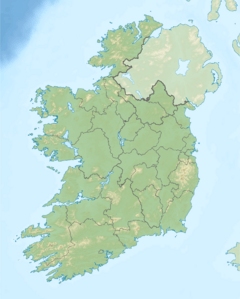Gibbet Rath executions facts for kids
Quick facts for kids Gibbet Rath executions |
|
|---|---|
| Part of the Irish Rebellion of 1798 | |
| Location | Gibbet Rath, Curragh, County Kildare |
| Coordinates | 53°09′08″N 6°51′35″W / 53.152197°N 6.859748°W |
| Date | 29 May 1798 Morning |
|
Attack type
|
Summary execution of prisoners of war |
| Deaths | 300–500 |
| Perpetrator | Militia, dragoons and yeomanry under the command of Sir James Duff |
The Gibbet Rath executions, also known as the Gibbet Rath massacre, happened during the Irish Rebellion of 1798. On May 29, 1798, government forces killed several hundred rebels who were trying to surrender. This event took place at the Curragh of Kildare.
What Led to the Executions?
In May 1798, a rebellion began in Ireland. Major-General Sir James Duff was a military commander in Limerick. He quickly gathered about 600 soldiers, mostly from the Dublin militia. They also had seven cannons.
Duff's goal was to march to Dublin. He wanted to reopen communication routes. He also aimed to stop any rebel groups he met. As his soldiers entered County Kildare, they found bodies of people killed by rebels. This made the soldiers very angry.
However, many rebels had already decided to surrender. Generals Gerard Lake and Ralph Dundas offered them a deal. The rebels had been defeated in a battle and agreed to give up their weapons. They were gathering to surrender at Knockaulin Hill on May 27.
General Duff did not know about this surrender plan. He reinforced his troops and marched towards the town of Kildare. From there, they moved to the Curragh plain.
The Events at Gibbet Rath
By the morning of May 29, Duff's force had grown to about 700 soldiers. These included militia, dragoons, and yeomanry. They also had four cannons. The rebels were waiting to surrender at Gibbet Rath. This was a wide, open plain.
Between 1,000 and 2,000 rebels were there, ready to give up their weapons. They expected to receive the promised amnesty. General Duff spoke to them, scolding them for their rebellion. He then ordered them to kneel and stack their weapons.
Soon after the rebels put down their arms, an attack began. Soldiers on foot and horseback charged the disarmed rebels. About 350 rebels were killed.
There are different stories about how the attack started. Rebels said Duff ordered his troops to attack. Duff, however, claimed the rebels fired first. Another story says one rebel fired his gun into the air, saying he wouldn't hand it over loaded.
General Duff later changed his official report about the event. He removed parts that showed he knew about the surrender plans. His original report mentioned that he had witnessed a "melancholy scene." It also noted that the rebels intended to surrender to General Dundas.
What Happened Next?
General Duff faced no punishment for the killings. When he arrived in Dublin the next day, he was celebrated as a hero. People held a parade for him. General Dundas, who had shown mercy to rebels, was criticized instead.
The Gibbet Rath executions had a big effect. Rebels who were thinking of surrendering changed their minds. They became less likely to trust government offers. Because of this, no more large groups of rebels surrendered in County Kildare until July. That's when William Aylmer finally gave up.
Historians believe that Generals Lake and Duff were not communicating well. They were on different sides of the Curragh. Duff and his 500 men had marched a long way from Limerick. They found Kildare town damaged by rebels.
Duff later took part in another military action. He tried to trap a rebel group in Wexford. This group was led by Anthony Perry. Perry's forces managed to escape Duff's troops in a battle on July 5.
Images for kids



